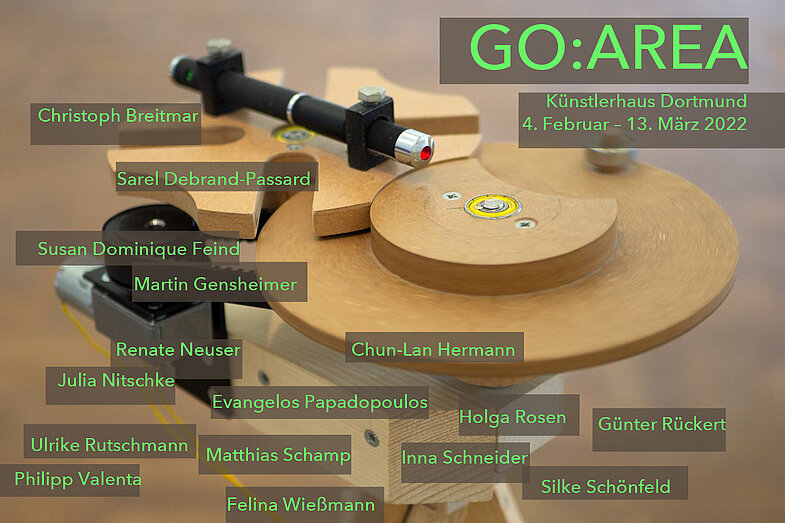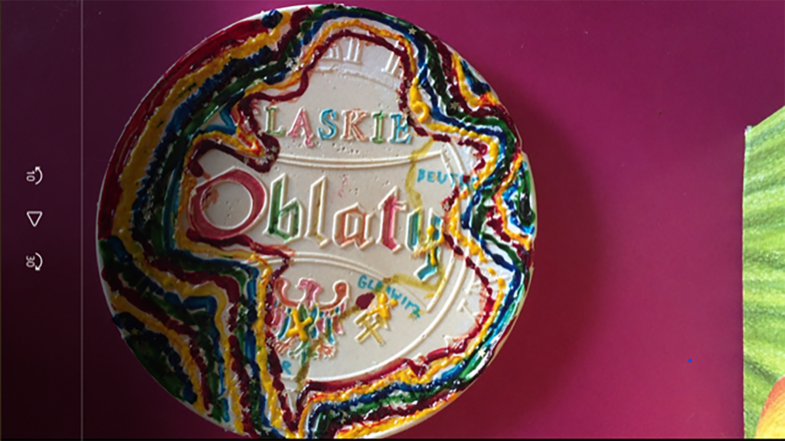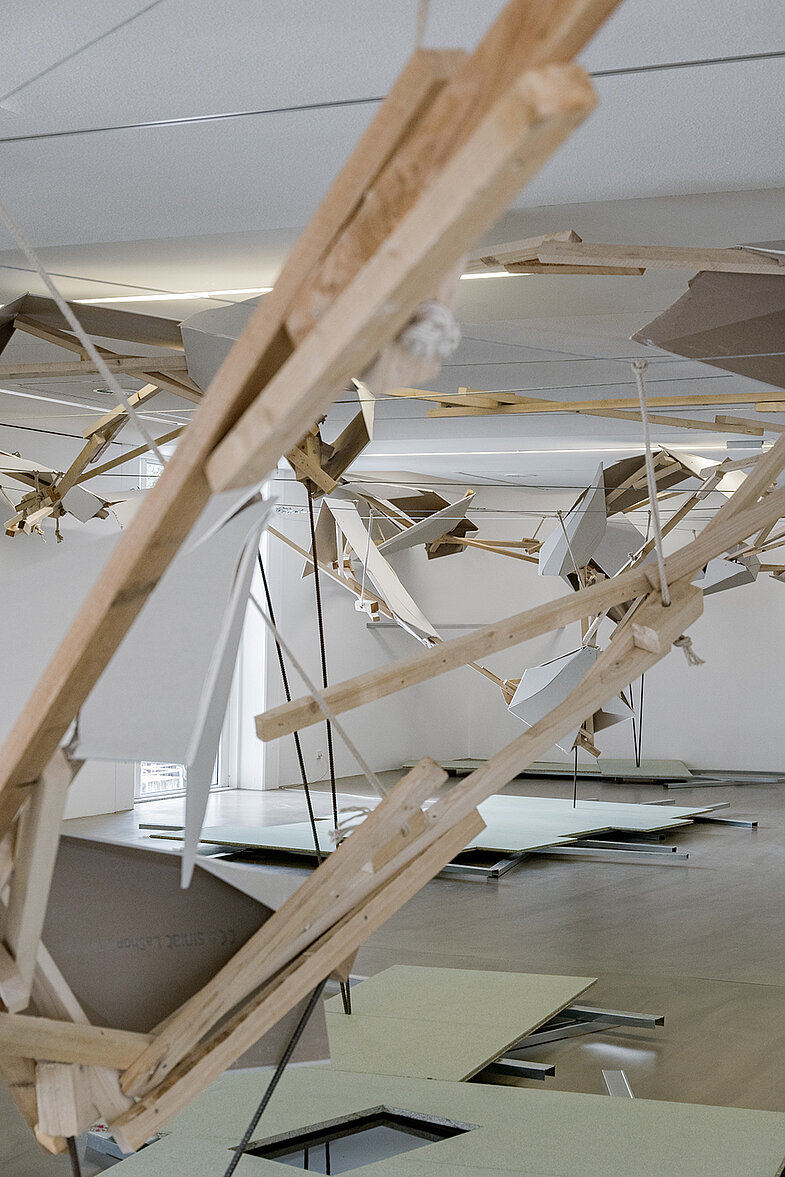
The Ruhr region - endless expanses, at least if you look at the artists from the region. There is so much that is exciting, moving and stirring that one can confidently rank here among the art locations of the republic. Last year, the members and KIN of the Künstlerhaus curated the exhibition "go local" in a joint effort with a view to Dortmund, i.e. the closer neighborhood. Now the view is broadened and the entire Ruhr region becomes a curatorial land of exploration: Proposals by the artists from Dortmund have become a multifaceted and exciting show that allows insights into one of the coolest regions of the continent - GO AREA.



"[…] Shades of white, barely distinguishable from one another, a primer that is paint or a paint that is primer, a sprayed color field that in many cases merges inconspicuously into the primer, and a top coat of synthetic resin that is applied only partially and, not unlike spar varnish, seals parts of the surface. The conventional image composition of canvas, primer, painting and varnish probes what painting actually is – or rather, where the limits of pain- ting lie. The question is not so much what a painting actually is, but rather what and how much it takes to be a painting. The geometric surfaces, their transparency implying virtually maximum abstraction, of “nothingness”, have a paradoxical function: in their minimally irregular surfaces, the inci- dent light refracts and produces, depending on the time of day and/or light source, diffe- rent amorphous patches of form and color that include the surrounding space as part of the surface in the composition." (Ulrike Lua)

"Nesw – everything the same"
Aligned with the cardinal points, aiming at the visitors, searching autonomous system. Interface between perception and the speed of light.
2020, laser pointer, wood, motor, battery
North east south west - no matter in which direction you walk, you come out at yourself - suppose you walk once around the globe. What about the light beam? Is it aiming into space or does gravity bend it around the earth? How long does it take to do that? What is time? This question, which can be answered almost exclusively through philosophy, is an attempt to locate itself. One for brief reflection: Is it a point or a line? A line or a ray? North is in any case straight ahead when we speak of the geographic North Pole? After all, the magnetic pole moves under our feet. There is something urgent about the whole thing.

Subversive Contact
Excerpts from my previous photographic work are printed on fabric and sewn into garments. Through the wearing of these garments, they become a presentation surface for my art as well as art themselves. By transferring the photographic work onto the fabric and sewing it, I reengage with my work from a new perspective.
My art is transferred into fabric patterns, worn and exhibited wherever I go
... on the road until further notice.

Based on the find of accidental drawings by forgotten pencils on books and other objects in his shoulder bag, Martin Gensheimer creates informal automatic pencil drawings. He uses pencils too short for hand drawings and fixes them with duct tape in his bag opposite a blank sheet of paper. He carries the prepared bag during everyday activities. Through his body movements the pencils start to draw in a kind of écriture automatique. Martin Gensheimer measures distance and length of time using a GPS tracker and combines the drawings with the data and description of his activities or motivation.

The two-part work consists of human hair trapped in between a pair of spherical and rectangular transparent foils, which are fixated on a picture frame by using nails on each corner of the foil piece. One foil is aligned vertically and the other one horizontally.
Chun-Lan Hermann's work deals with the corona pandemic, which represents the rift in society. Since 2020, humanity has been in an uncertain and diffuse space in which uncertainty and fear is spreading.

I use a wide variety of materials - natural and manufactured: paper, cellophane, cardboard, wood, wire, string, stearin, silicone, wood glue, etc. and I use found objects from nature and human everyday life. They are treated in many ways - bent, glued, waxed, hardened, pierced, wrapped, dried - altogether changed, condensed, dissolved, puzzled.
The resulting objects reflect the material, the material in its sensuality and beauty, strangeness and ugliness. They lead into an enigmatic world of things and materials, in which the origin and composition of the substances is unknown, made things appear as if found, and things are completed to unfathomable form. Furthermore, my works relate to nature - to imagined early stages of evolutionary processes, to dreamed or feared results of human intervention, to biological microstructures of unimagined extent.
There are a number of small sculptures presented on pedestals or shelves. The larger objects are often series or families of forms placed on pedestals and tables. My floor and wall installations are also composed of series of similar elements.

In the framework of a stipend Julia Nitschke dealt with her upper silesia family background. Main character of the shortfilm is a wafer, which demonstrates that all the family tales are connected with each other, doesn’t matter if imagined or true.

"From simple, commercially available building materials such as gypsum boards, roof tiles, monorails, LED light tubes and Steel U-profiles the artist mounted over-arching structures extending far into the rooms, which seem to be dominated by complicated movement tendencies pointing in different directions. Without using neither plans of construction nor prefabricated sketches, Papadopoulos intuitively builds his temporary large-scale sculptures entirely intuitively, letting them "grow" into the space piece by piece spontaneously and in constant confrontation with the particular place, its atmosphere, its functions and light conditions." (Dr. Peter Lodermeyer)

Holga Rosen has been drawing cartoons for daily, satirical, trade and other magazines for over 20 years. The jury of the German Cartoon Prize, where he won 2nd place in 2020, judged his punchlines to be "edgy". Rosen ignores the obvious, prefers to think and illustrate around two or three additional corners. His cartoons are sometimes mild, but mostly biting, always cast in a quaintly striking stroke, which one can attest to anarchic qualities, masterly reduction, aggressiveness and a resourceful power of observation" (Kai-Uwe Brinkmann, Ruhr Nachrichten).
While he initially experimented wildly with a wide variety of tools (pencil, felt-tip pen, watercolour, pastel chalk, watercolour, ink, etc.), I have been drawing exclusively digitally on an Android tablet for a few years now.

Born in Lower Saxony, grew up in Dortmund and studied in Bochum, Günter Rückert is one of the most distinguished artists of this region. After first satirical works in the 70s parallel to first free theater projects, he decided in 1986 to become a freelance artist. His paintings were and are shown in numerous exhibitions in the country and occasionally abroad. They are the subject of various private and public collections and include whimsical graphics and free painting, as well as works in public space. Both in theater projects (including Nachtschicht, Geierabend) and in his visual art, he reflects on social conditions and trends in a biting, oblique and witty manner. Günter Rückert is the spokesman for the Dortmund artists' associations and a member of the art advisory board of the city of Dortmund.

The focus of my image series "visual cortex I_I - I_III" is the process of perception. How much or how little color and contour are necessary to make a pictorial motif appear or disappear? In a lengthy process, I layer diaphanous paint skins on top of each other, wash them out, paint them over again and again, until the open structures on the surface of my paintings meet with the physical and psychological experiences of the viewer and a pictorial motif very gradually crystallizes. In the oscillation between ephemeral pictorial spaces and real designs of reality, I find in the tension the approach to the fragility of human existence.

Infraframing
Participation & Performance in the Age of Zoom Conferences
Infraframing is an intersubjective collage technique developed by Matthias Schamp. The images generated and secured by screenshot are based on the agreement of the session members forming a tableau. The joint action leads to a sometimes more, sometimes less successful realization of this image idea developed in the team. One should not underestimate the difficulties of e.g. mirrored videos, differently arranged frames on the respective screens or deviating scaling.

The Rhein-Herne-Kanal, which begins in Duisburg and flows into the Dortmund-Ems Canal, was originally built between 1906 and 1914 for economic purposes, primarily as a transport route for coal, iron and steel. But since then it has also become a popular place for many people: cyclists, walkers, anglers, boaters and bathers of all ages will find that they can spend their free time here together. For numerous young people it is a popular meeting point too: there, in front of an industrial backdrop amongst scraps heaps and industrial wasteland, they swim, picnic, grill and enjoy mild summer evenings. In summer of 2019 Inna Schneider visits the canal in Herne and captures momentary but also clear images of days and evenings of adolescents and young adults between the ages of 12 and 25 years. In combination with photographs of the Rhine-Herne Canal, its surroundings, nature and things left behind, it conveys a feeling of freedom and lightness and at the same time the transience of a carefree youthful summer. Many Herne residents associate these or similar feelings and memories with the Rhine-Herne Canal, as well as with a good friend, the „Kumpel Riviera“.

A film portrait of a 16-year-old Thai boxer from Dortmund that goes beyond the usual narrative. With impressive self-assurance, Aleyna Asya Akgün devotes all her leisure time to this still male-dominated martial arts form. The camera closely follows her during the preparation for the European Championships in Duisurg. We directly witness the physical and emotional experiences she shares with us, creating a sense of closeness to the protagonist.

"Initially the canvas appears as an unutilised, empty and yellowed picture support, worn out and aged. The stains are reminiscent of sullied mattresses or bed sheets and emerge from the carrier material cotton’s creamy, off-white tonality only very subtly. It’s then that we distinguish between surface and what’s been applied. With fine nuances, a monochrome picture appears, which shows the canvas more as the carrier of color than the color itself. Without subject and mimetic meaning, the painting eludes being easily “consumed”. Avoiding composition underpins the ephemeral character of the monochrome.
Avantgarde artists of the 1950’s such as Yves Klein used monochrome painting techniques to rail against traditional painting in favor of an emptiness, devoid of all meaning. According to Wollheim and his wording of the “Kunst-Gehalt” (artistic yield, TN) this is a reduction of a representational image taken to its limits: an undifferentiated, monochrome surface. The real production is visible as a trace of the act of painting, inherent and perceivable in each work.
In the works of Philipp Valenta this is different, and has to be named as such. The “void” which is given by monochrome painting through their conventionalized art history, is undermined by the works materiality as well as the creative process. The nuances in colour are derived by soaking the fabric in champagne. When the whole liquid evaporates,, the fabric is mounted on a stretcher. Therefore Philipp Valenta does begin with the mounted canvas, and the moment of chance, provoked by the artist, becomes evident in the production process.
As an abstract painting, it only represents itself, and only the material allows us to connect the aesthetics of the painting with ideas on champagne. In the discursive field of the commodity (champagne), each work’s title, which is the same as the champagne used to create it, includes high-class brands alongside “cheap products”. With this, the title becomes, alongside the material itself, a starting point of ideas and their connections. In "Comtesse Marie-Louise by Penny" we may think about the social rank of counts and nobility and and let ourselves be carried away to Champagne which signifies - since the 17th century - class, affluence and resplendence… until all reputation evaporates." (Roger Rohrbach, art historian and curator; translation: Philipp Valenta, Nathan Hall)

In my current work I have dealt within oil paintings with the absence of events in public and private space. The fun culture designed for consumption stands still. I was particularly interested in the abandoned and left behind places where previously debauched dancing and partying. I was also drawn to the closed places of cultural gathering and exchange, such as museums, galleries, cinemas, theaters, or café houses. The spaces of leisure and education became a kind of "lost place." In these "forgotten places" I made numerous charcoal and pencil drawings in my preliminary work for painting. Subsequently, these drawings developed further in my painting. For me, a reconquest of space through figurative painting took place there.
It cannot be made out whether the ghostly persons are about to manifest themselves or are just dissolving. Some of the people depicted are engaged in conversation, while others sit at tables, chairs, and in corners, deep in thought. In the painting process flowed always the longing for sociality, this desire for communication and exchange in times of a pandemic. Strengthened by the back and forth of the openings and closures, the disappearance and manifestation of the figures on the picture ground developed automatically for me in the course of the painting process.
The depicted environment of the figures can be diverse, for example, a bar, concert halls, bunkers or their own apartment. Different impressions are processed, from intimate moments of togetherness to larger gatherings. A silent couple with a dog sitting in front of a blue light window, "band rehearsals" which are more reminiscent of small secret concerts, tattooing in the living room or DJ evenings to stream them on the Internet. Another component for me was the implied painting style of the interiors. These seem partly gloomy and run down, but often have light windows into the seemingly outer (inner of the image space). It remains uncertain with this diffuse picture surface whether it is a window, a mirror, a luminous body or a screen.
The pictorial power of painting has exactly the right sensitivity for me to deal with this subject. Medialization, new readings and rapid transformability should be examined and bound in the longing for the original, the painting. The attempt of expression on a metaphysical level, where I do not know how to express myself otherwise. In painting I can condense this abstract world of feelings and my thoughts. The solitary and silent process of painting is supportive in two ways: analytical, self-forgetful and at the same time self-questioning. There I want to put the durability, permanence and timeless meaningfulness in current context. In this way I am always in search of an abstract truthfulness and credibility that moves me in the innermost.